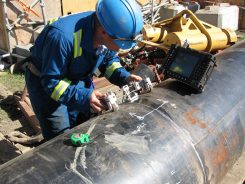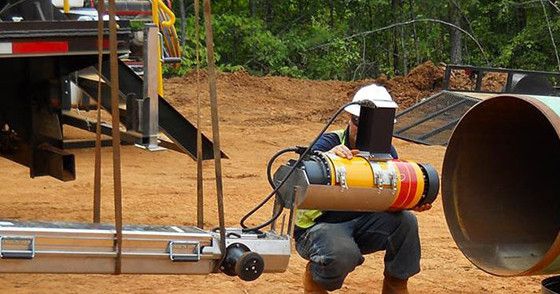Comprehensive Overview of Pipe Welding Evaluation Procedures
Pipe welding assessment treatments play a vital function in ensuring that welded links fulfill stringent sector standards and specifications. From careful pre-welding assessments to detailed post-weld assessments, a distinct examination process is essential for preserving the architectural strength of pipes.
Pre-welding Evaluation Preparations
Before beginning the welding process, thorough pre-welding evaluation prep work are important to make certain the honesty and quality of the weld joint. These preparations involve a precise exam of the products to be bonded, the welding tools, and the job environment. By carrying out comprehensive pre-welding assessment preparations, possible issues can be identified and resolved early on, leading to top notch and dependable weld joints.
Welding Treatment Qualification
Complete pre-welding examination preparations lay the structure for the important procedure of Welding Treatment Qualification, ensuring the integrity and high quality of the weld joint. Welding Treatment Credentials (WPQ) is a crucial action in the welding process that involves testing and licensing welding treatments to ensure they fulfill specific standards and requirements. The WPQ process normally includes welding treatment requirements development, welding procedure certification testing, and documents of the results.
Throughout welding treatment specification advancement, essential details such as the welding procedure, welding materials, joint style, and welding criteria are defined to develop a comprehensive procedure. Ultimately, welding procedure credentials testing is performed to validate the proposed procedure's integrity. This testing commonly includes welding test discount coupons that are subjected to different mechanical and non-destructive examinations to evaluate the weld's high quality and adherence to the specified requirements.
In-process Weld Examination
During the welding procedure, in-process weld assessment plays a crucial function in ensuring the high quality and integrity of the weld joint - Pipeline Welding Inspection. This type of assessment entails keeping an eye on the welding specifications, analyzing the weld grain development, and discovering any kind of possible flaws or stoppages as they happen. By conducting in-process weld examinations, welding drivers can quickly deal with any issues that may emerge, thus making certain and protecting against more defects that the final weld meets the needed requirements
Typical approaches made use of for in-process weld assessment consist of aesthetic assessment, liquid penetrant screening, magnetic fragment testing, ultrasonic screening, and radiographic screening. Visual evaluation is usually the very first step at the same time, enabling inspectors to aesthetically examine the weld for surface abnormalities such as splits, porosity, or insufficient blend. Much more advanced approaches like ultrasonic screening and radiographic screening give in-depth understandings into the internal framework of the weld, making certain that there are no he has a good point surprise issues that could jeopardize the weld joint's stamina and honesty. In general, in-process weld inspection is essential for keeping the high quality and integrity of bonded pipelines.
Non-destructive Screening (NDT)
Non-destructive Screening (NDT) is a critical approach employed in pipe welding evaluation to analyze the stability of weld joints without creating damages to the welded framework. By using different NDT methods, inspectors can assess the top quality of welds and identify any kind of flaws or interruptions that might endanger the structural sturdiness of the pipeline. Common NDT techniques used in pipeline welding inspection consist of Radiographic Screening (RT), Ultrasonic Testing (UT), Magnetic Particle Evaluating (MPT), Fluid Penetrant Screening (LPT), and Visual Testing (VT)
RT includes the usage of X-rays or gamma rays to create pictures of the internal framework of the weld, allowing examiners to discover problems such as porosity, fractures, or incomplete fusion. UT makes use of high-frequency audio waves to find problems under the surface of the weld, providing thorough information about the dimension and area of flaws. MPT and LPT are made use of to identify surface-breaking problems by using magnetic bits or penetrant fluids to the weld area. Additionally, VT includes visual evaluation of welds to recognize any noticeable blemishes.
Post-weld Evaluation and Documentation

Documents of post-weld inspection findings is necessary for preserving quality assurance documents and ensuring conformity with market requirements and regulations. Comprehensive records should include info about the evaluation approaches used, the location and nature of any issues found, and any restorative activities taken - Pipeline Welding Inspection. Correct documents not only functions as a record of the weld's high quality but additionally help in future upkeep and inspection processes
Verdict

In final thought, pipe welding examination treatments play a vital duty in guaranteeing the quality and stability of welds. In general, adherence to correct inspection methods is essential to the success of pipe welding projects.
From thorough pre-welding assessments to thorough post-weld assessments, a well-defined assessment procedure is vital for keeping the structural soundness of pipelines. By conducting in-process weld examinations, welding operators here can without delay resolve any type of problems that may emerge, thereby guaranteeing and preventing additional issues that the last weld fulfills the called for specifications.
Common methods made use of for in-process weld evaluation include aesthetic examination, fluid penetrant testing, magnetic fragment screening, ultrasonic testing, and radiographic testing.Non-destructive Testing (NDT) is an important technique used in pipeline welding evaluation to analyze the honesty of weld joints without creating damages to the welded structure. Post-weld inspection involves various techniques to evaluate the welds for issues, consisting of visual assessment, dye penetrant screening, magnetic fragment testing, ultrasonic testing, and radiographic testing.